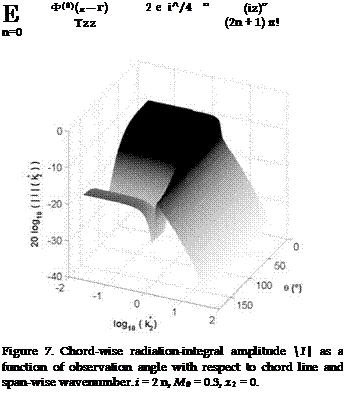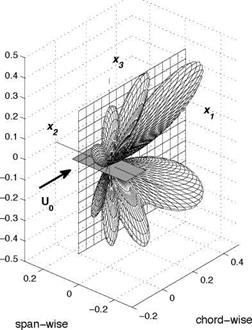Radiation Integrals of Oblique Gusts
The trace determined by Schwarzschild’s technique provides the pressure jump along the airfoil, acting as the equivalent source distribution. The acoustic field is calculated now from the sources by a classical radiation integral. This is equivalent to resorting to Ffowcs Williams & Hawkings’ acoustic analogy. The sources are exactly the dipole contribution of the analogy, recognized as dominant at subsonic Mach numbers. Since the problem is solved in a non-compact and compressible context, the solution implicitly accounts for the auto-diffraction by the surface. But if the formalism is to be applied to rotating blades, mutual diffraction between adjacent blades, if any, is not accounted for, because Amiet-Schwarzschild’s approach provides isolated-airfoil response functions. For non-overlapping blades or low-solidity fans within the scope of a strip-theory approach, this other simplification is fully acceptable. Oppositely high blade counts typi
cal of some turbomachines would in principle require the implementation of cascade response functions, much more expensive and time-consuming, not addressed here.
The far-field radiation for a single gust is expressed in a reference frame attached to the airfoil as
![]() ikcp0 x3 и w L sin[L (k* – k* x2/So)/c] 1 2 S2 0 W L (k* – k* x2/S0)/c
ikcp0 x3 и w L sin[L (k* – k* x2/So)/c] 1 2 S2 0 W L (k* – k* x2/S0)/c
with k* = kc/2, where the sine-cardinal function sin ^/^ represents the span-wise radiation integral and where the non-dimensional chord-wise radiation integral (or aeroacoustic transfer function) I is introduced as
![]()
In the expressions (x1,x2,x3) stand for observer’s coordinates with origin at the center of the airfoil, respectively in the stream-wise, span-wise and normal directions. S0 = [x2 + в2 (x2 + x3)]1/2 is a corrected distance accounting for sound convection by the surrounding flow. It is close to the geometrical distance R only if M0 is small. L is the span. The sine – cardinal function accounts for the span-wise interference associated with the wavenumber k2. The function I has different expressions for the sub-critical and supercritical gusts, including leading-edge and trailing-edge contributions: I = I1 + I2. For supercritical gusts it reads (Roger (2010))
with 02 = p (Mo – xi/So) – п/4, 03 = к + pxi/So, 04 = к – pxi/So. For sub-critical gusts the expressions follow as
with 04 = iK — pxi/So, 03 = iK + fixi/So.
For the sake of robustness the Fresnel integrals and related functions are better implemented using the following relationship with the complex error function of complex argument
 |
and the algorithm
The amplitude of the radiation integral I is plotted in decibels and in logarithmic k|-scale in Fig. 7 for an arbitrary set of parameters, as a function of observation angle with respect to the chord-wise direction. The plot emphasizes a rapid drop for large values of k|, and a plateau for small values at fixed angle. Note that interpolation has been performed between the supercritical and sub-critical ranges to smoothen the response surface at the singular value Щ = в p, for which the two-step Schwarzschild’s procedure breaks down because the effective frequency parameter к is exactly zero. At some angles the dip in the supercritical range a priori makes the sub-critical gusts more significant contributors. This dip is caused by cancellations which result from chord-wise non compactness. At lower frequencies (typically p < n/4) the plateau would extend nearly constant whatever the observation angle could be. In contrast at even higher frequencies, multiple dips would be found.
The complete directivity pattern of a single oblique gust results from the combination of this radiation integral with the additional sine-cardinal function, on the one hand, and the factor x3/S0 which accounts for the dipole character of the lift fluctuations, on the other hand. For non-compact chords and supercritical gusts it exhibits multiple inclined lobes. Another sample result with different parameters is plotted in Fig. 8. The four lobes result from chord-wise non-compactness associated with the relatively high reduced frequency. They are inclined away from the mid-span plane because of the obliqueness of the gust, as first pointed out by Amiet (1975). The radiation would be preferentially in the mid-span plane for a parallel gust. The larger the aspect ratio L/c, the thinner the lobes. In the limit of infinite aspect ratio, a single oblique angle would be selected. As frequency increases, not only the number of lobes increases but the radiation also takes place with more pronounced beaming downstream. In the limit of arbitrary large frequencies, as shown later on, the diagram would become cardioid – like with a maximum downstream; this is a typical feature of the half-plane Green’s function already identified in chapter 2. In contrast to supercritical gusts, sub-critical ones cannot produce multiple radiation lobes nor oblique focusing.
Globally the chord-wise radiation integral behaves like a low-wavenumber filter. The sine-cardinal factor acts as a band-pass filter centered on the wavenumber Щ = k*x2/S0 which gets progressively thinner as the aspect ratio increases. The wider it is, the more likely the sub-critical gusts contribute. More precisely if the observer gets closer to the mid-span plane, the sub-critical gusts bring a poor contribution. In this case the parallel and nearly-parallel gusts are responsible for the major sound. As x2/S0 increases the sine-cardinal filter shifts towards larger values of k2 and gives more im-
|
Figure 8. Typical directivity diagram of an oblique supercritical gust. kc = 12.57, p = 6.3, M0 = 0.05, Щ = —1.26, L/c = 2. Arbitrary units. |
portance to sub-critical gusts. But in the same time extreme observer positions close to the airfoil plane along the span correspond to vanishing values of x3 for which the dipole directivity factor makes the contribution smaller and smaller. This is why, again, sub-critical gusts are often discarded for simplicity. Yet in view of the three-dimensional plot of Fig. 7 their relative contribution can be significant if the sound must be evaluated for all possible observer locations and for all configurations. This is precisely what is needed in rotating blade noise studies.
Because the present discussion is a question of gust obliqueness combined with convection Mach number, it will also hold in the subsequent analysis of trailing-edge noise, based on the same mathematical background.
1.4 Extensions
One of the most striking aspects of aforementioned Amiet-Schwarz – schild’s technique is its wide range of extension capabilities. First it is applied later on to derive formulas for trailing-edge noise and vortex-shedding noise; secondly it has also been used to account for realistic features departing from the restrictive assumption of a rectangular airfoil the edges of which are perpendicular to the mean flow. The former advantage makes the analytical models of the three mechanisms addressed in this chapter quantitatively comparable, because they are built on the same basis. The latter allows introducing more physics in the models, thus offering more practical interest. But it is beyond the scope of the present document. Only indicative examples of reported works that are expected to enlarge turbulence-impingement noise modeling are listed below as an open door towards further extensions.
1 – Impingement of disturbances on a swept edge. Because the span – wise extent of the airfoil is assumed infinite for the sake of determining the induced lift, sweep, defined as a possible arbitrary angle between the leading edge and the flow direction, is simply accounted for by performing a change of variables and introducing Cartesian coordinates along and normal to the edges, thus oblique with respect to the flow direction. First derivations of the lift distribution £ are reported by Adamczyk (1974), based on the Wiener-Hopf technique. Equivalent solutions are obtained with Schwarzschild’s technique, and lead to extended expressions of the radiation integrals, as shown by Roger & Carazo (2010). Essentially the effect of sweep is to shift the threshold between supercritical and sub-critical gusts by changing the relative edge-to wavefront angle and the associated span-wise phase speeds of the interaction.
2 – Effect of varying chord length. Fan design usually involves span-wise variations of all geometrical parameters of a blade. Therefore any blade segment in a strip-theory approach can have different chords at both ends, or equivalently non-parallel leading and trailing edges. This again can be included in Amiet-Schwarzschild’s approach, provided that some approximation is accepted. Indeed both edges are treated separately as edges of half-planes. Once the dominant leading-edge scattering is determined by the first iteration in the same way as for a rectangular airfoil, a change of variables is performed in order to project the solution £1 in a new set of coordinates aligned with the trailing edge. The procedure, detailed by Roger & Carazo (2010), requires a splitting of £1 into trailing-edge aligned secondary gusts, which is only valuable for segments of moderate aspect-ratio.
3 – Unsteady response of a blade tip. Because the highest relative flow speeds on rotating blades are encountered at the tip, the effect of the blade termination upon the unsteady aerodynamic response is a key issue, especially if the oncoming disturbances concentrate to precisely impinge near the tip. Again Schwarzschild’s technique provides a way to include the tip effect in the analysis. Detailed derivations are also described by Roger & Carazo (2010), for the tip of a rectangular unswept airfoil. The principle is as follows. The unsteady lift determined ignoring the tip is first continued by zero away from the airfoil surface and expanded in Fourier components. For each component the lift is forced to zero beyond the tip by adding a correction which is solution of another Schwarzschild’s problem, now in the span-wise direction instead of the original stream-wise statement. The inverse Fourier transform is finally performed numerically to get the corrected response. Application to blade-tip vortex interaction noise modeling is proposed by Roger & Schram (2012).
4 – Different convection and free-stream velocities. In some analytical reductions of practical problems, oncoming disturbances can need being assumed with a convection or phase speed that differs from the free-stream velocity involved in the far-field radiation. For instance, this would be the case for the turbulence generated in the flap cove of a wing with deployed high-lift devices and impinging on the flap leading edge. Though seldom addressed this extension is quite straightforward. It is not discussed here because similar statements are mentioned in the next sections for trailing – edge noise and vortex-shedding noise modeling.












